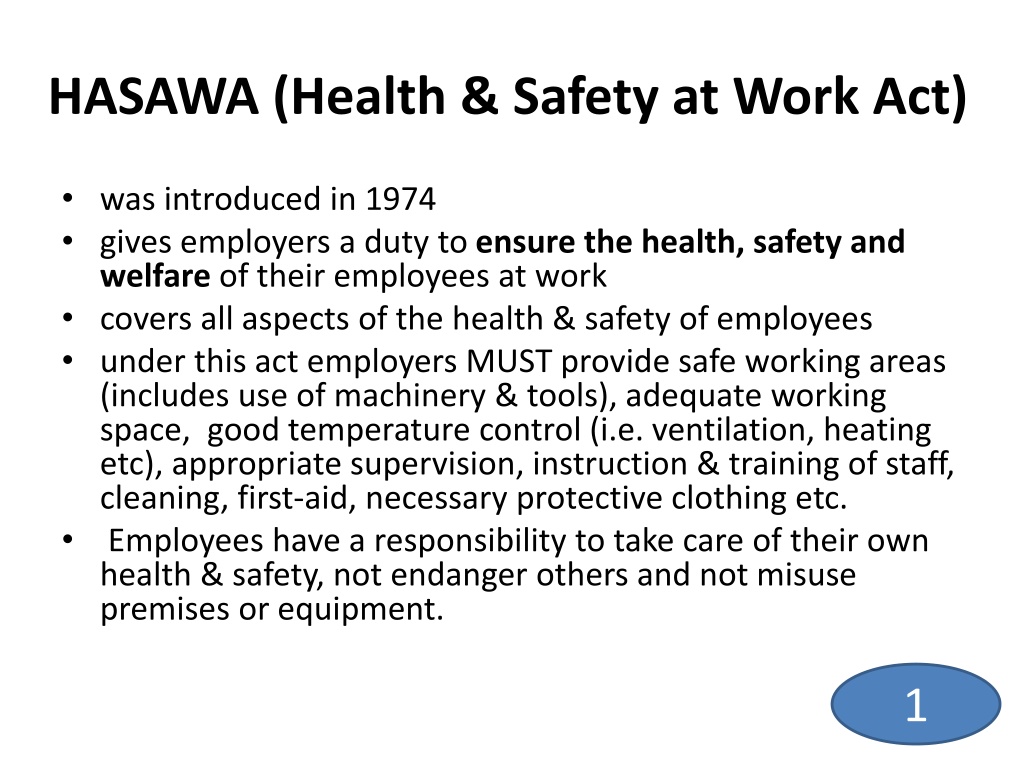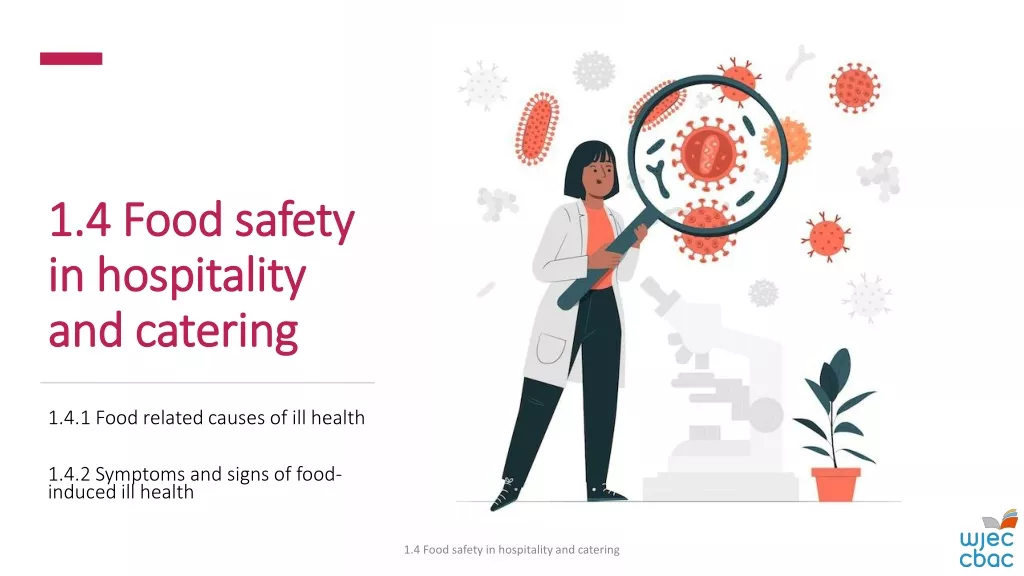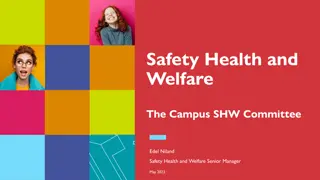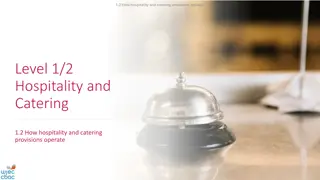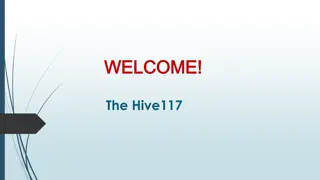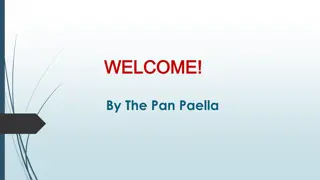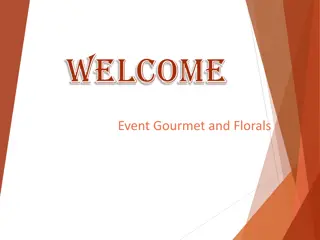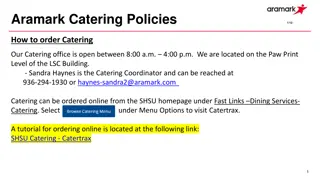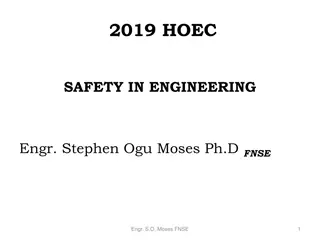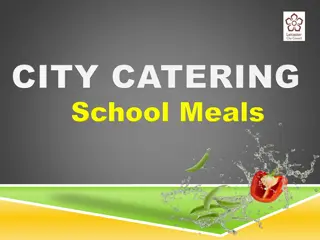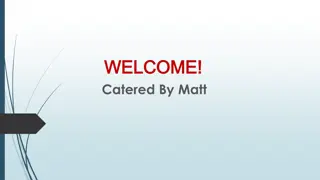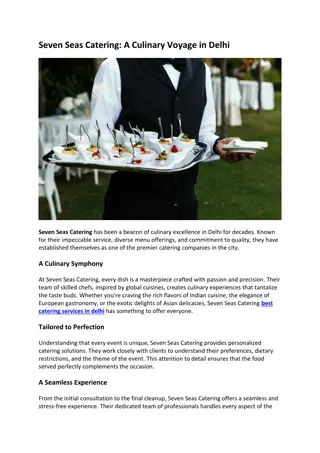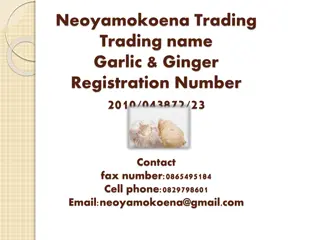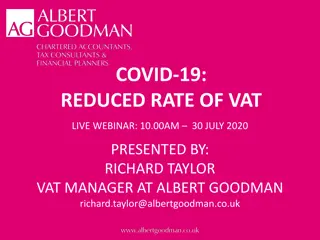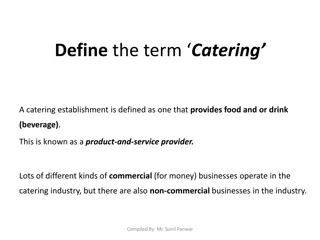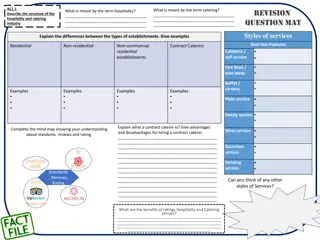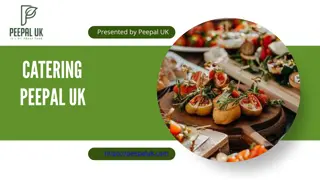Health and Safety Regulations in the Catering Industry
The Health and Safety at Work Act (HASAWA) introduced in 1974 places a duty on employers to ensure the health, safety, and welfare of their employees at work. This act covers various aspects such as providing safe working areas, adequate lighting, sufficient ventilation, proper maintenance of equipment, first aid facilities, and more. Employers must follow regulations related to accidents, reporting of injuries, and preventive measures. It is crucial for both employers and employees to be aware of their responsibilities to maintain a safe working environment, especially in industries like catering.
Download Presentation

Please find below an Image/Link to download the presentation.
The content on the website is provided AS IS for your information and personal use only. It may not be sold, licensed, or shared on other websites without obtaining consent from the author. Download presentation by click this link. If you encounter any issues during the download, it is possible that the publisher has removed the file from their server.
E N D
Presentation Transcript
HASAWA (Health & Safety at Work Act) was introduced in 1974 gives employers a duty to ensure the health, safety and welfare of their employees at work covers all aspects of the health & safety of employees under this act employers MUST provide safe working areas (includes use of machinery & tools), adequate working space, good temperature control (i.e. ventilation, heating etc), appropriate supervision, instruction & training of staff, cleaning, first-aid, necessary protective clothing etc. Employees have a responsibility to take care of their own health & safety, not endanger others and not misuse premises or equipment. 1
Examples covered by the legislation & relevant to working in the Catering industry include: Obstructions - such as equipment, boxes, trailing cables, etc (prevent tripping) Spillages much be cleaned up (to prevent slipping) Work areas must have adequate lighting All surfaces capable of being kept clean Sufficiency of floor area - positioning of equipment in relation to work processes. Adequate storage space for the amount of stock normally kept Have a safe method of draining of hot oil from catering equipment, to prevent burns Diluting/mixing/decanting cleaning chemicals Dismantling/cleaning dangerous equipment, e.g. Food slicers/mixers etc Regular cleaning and removal of waste materials Have periodic checks on the fixed electrical system by a qualified electrician Have procedures to maintain the safety of electrical equipment including user checks, formal visual inspection and combined inspection and testing (where necessary) PAT testing. Safe maintenance of equipment - Ensure proper maintenance and use of all equipment Training in the use of hazardous equipment e.g. Slicing/chopping machines, mixers. Sufficient and suitable first aid equipment, facilities and personnel Suitable notices should be displayed in the workplace. Suitable and sufficient ventilation to avoid excessive build-up of heat and to remove cooking fumes Assessments will be required, particularly in relation to cleaning chemicals (COSHH). Carry out risk assessments where required Ensure all staff are aware of hazards and are either informed, instructed or trained in risk control procedures
Accidents - Procedures & Prevention Under RIDDOR (Reporting of Injuries, Diseases and Dangerous Occurrences Regulations came into force 1996) an employer has the legal responsibility to report work related injuries. This refers to death or major injury (immediate notification) and over 3 day injury where an employee is unable to work because of the injury for 3 days or more - (notification within 10 days of injury). Accidents & injuries should be reported to the local authority environmental health department. Most catering establishments will have an accident book which gives a clear statement of events leading up to an accident (even if the injury does not appear serious at first). Details to be included in the record should include: 1. Name & sex (of injured) 3. Place (where accident occurred) 5. What part of the body was injured 7. Any first aid that was given 9. Witnesses, supervisor 2. Exact time & date (of accident) 4. What happened 6. and how badly 8. Any further treatment necessary 10. Whether worker was doing his job 2
The most likely types of accidents in a Catering kitchen include: Falls Cuts Burns & scalds The main dangers(and how to avoid them) include: Floors keep grease free, mop up spills immediately, keep pathways clear of obstructions Knives take care when using, keep handles clean & grease free, do not put in washing up bowls Electrical equipment check in working order, check cables/wires in good condition, do not use with wet hands or near water, use safety guards, turn off when not in use Hot pans take care when moving/lifting, use oven gloves/cloths, turn pan handles away from sides/edges of cooker/surface, do not use wet cloths for hot pans Fryers do not overfill, do not place wet foods into fryers, lower food into fryer carefully, change fat regularly Foods meat & fish bones can cause cuts, frozen foods can cause burns , take care when opening & disposing of cans & jars
Simple First Aid First aid can be defined as the immediate treatment necessary for the purpose of preserving life and minimising the consequences of injury or illness until expert medical assistance can be obtained It also includes the initial treatment of minor injuries which will not need treatment by a medical practitioner. Remember the three P s Promote recovery, Protect the patient, Prevent injury from becoming worse There should always be a first aid box available in the catering kitchen The location of the first aid box should be known by all members of staff Notices should be shown appointing the first aiders of the establishment First aid boxes should be made of suitable material to prevent contents from damp and dust 3
The first aid box should include: A card giving general fist aid guidance Individually wrapped sterile un-medicated adhesive dressings of assorted sizes in blue some should be waterproof Sterile eye pads with attachments Individually wrapped triangular bandages Safety pins Medium sized sterile un-medicated wound dressings Large sized sterile un-medicated wound dressings Disposable gloves The contents of the first aid box should be checked and replenished regularly this is usually the responsibility of a nominated person (probably a first aider)
Fire Safety To prevent the outbreak of fires in the kitchen: Do not have flames larger than the size of the pan (gas hobs) Do not leave cloths or oven gloves over cookers Time the cooking of food accurately Take special care when cooking with hot fat it can spit & set alight Have fire blankets & extinguishers handy Have clear fire procedures Fires are classified according to their source/severity: Classification: Class A Class B Class C Class E Class D Class F Fuel/Heat source Ordinary combustibles Flammable liquids Flammable gases Electrical equipment Combustible metals Cooking oil or fat 4
Fire Fighting! A fire blanketis a safety device designed to extinguish small incipient (starting) fires. It consists of a sheet of fire retardant material which is placed over a fire in order to smother it. Type Label colour Use for / limitations to use Combustible materials (wood, paper, textiles etc.) Not electrical fires/equipment Not flammable liquids Water Red 9-litre-water-fire-extinguisher3 Catering establishments must have a system in place for the safe evacuation of the premises in the case of an outbreak of fire (or other emergency) Small fire blankets, for use in kitchens and around the home, are usually made of fibreglass, and are folded in to a quick- release container for ease of storage. Foam Flammable liquids Not electrical fires/equipment Cream foam-extinguisher-cream CO2 Fire Extinguishers CO2 (Carbon Dioxide) Fire Extinguishers are suitable for class B risks involving flammable liquids and for electrical hazards. CO2 is harmless to electrical equipment and is used for fires caused by the combustion of liquids such as: oils, fats etc Dry Powder Blue powder-fire-extinguisher1 Combustible materials (wood, paper, textiles etc.) Flammable liquids and gases Electrical fires/equipment Electrical fires/equipment Flammable liquids and gases (less efficient than foam or powder) Water Fire Extinguishers Water Fire Extinguishers are suitable for class A fires, involving solid materials such as: wood, paper, straw, textiles, coal etc. The water cools the fire and penetrates quickly into materials. Carbon Dioxide Black carbon-dioxide-fire-extinguisher Exit routes must be clearly signed Powder Fire Extinguishers Green Halon (poisonous gas) de-oxiginates air to put out fire Electrical fires/equipment Flammable liquids and gases Not in small enclosed spaces HalonGasSmall Dry Powder fire extinguishers are suitable for the majority of fires (Class A, B and C).
COSHH The Control Of Substances Hazardous to Health Regulations 1999 the law requires employers to control exposure to hazardous substances to prevent ill health. Hazardous substances used in the catering industry will include cleaning agents. A warning label will usually indicate whether COSHH is relevant and a safety data sheet should be available The COSHH safety data sheets should include details about such things as: Correct use and storage e.g. dilution quantities for concentrates Any PPE required (Personal Protective Equipment) e.g. safety goggles may be required when mixing or decanting certain chemicals; rubber gloves may be recommended when using cleaning chemicals Effects of exposure e.g. skin rash, itchiness etc Emergency procedures e.g. what to do if swallowed, in contact with skin, eyes etc 5
There are 7 basic steps to follow in order to comply with COSHH regulations: 1. Assess the risksto health arising from using the substance 2. Decide what precautions are needed 3. Prevent, or adequately control, exposure 4. Ensure control measures are used & maintained 5. Monitor the exposure 6. Carry out appropriate health surveillance 7. Ensure employees are properly informed, trained & supervised The effects of contact or misuse of chemicals could be: Skin irritation or dermatitis as a result of skin contact Asthma as a result of developing an allergy Losing consciousness (if overcome by toxic fumes) Cancer which may appear long after the exposure to the chemical that caused it Infection from bacteria & other micro-organisms (biological agents)
Quick Recall 1. What does HASAWA stand for? 2. What is RIDDOR? 3. What is COSHH? 4. What are the 3 most likely causes of accidents in a catering kitchen? 5. What does a BLUE labelled fire extinguisher denote? 6. What are the 3 P s? 7. What items should be in a first-aid box? 8. Where/who should major injuries be reported?
Exam practice 1 Hazards in a catering kitchen can cause accidents. Complete the chart identifying the action that should be taken to prevent an accident (4) Hazard Action to be taken (i) A wet floor (ii) Worn or damaged flex on an electric mixer (iii) Misuse of equipment (iv) Boxes of cartons left on the floor
Exam practice 2 Safe working in the kitchen is important This question is worth 12 marks or 15% of the TOTAL marks (12/80) so you should aim to spend about 10-11 minutes (15% of your time) developing, recording & checking your answer a) State two aims of the Health & Safety at Work Act (2) b) Identify the major causes of accidents in a commercial kitchen (4) c) Discuss ways in which accidents in the catering kitchen can be avoided (6)
More Recall 1. Under which act is it the duty of an employer to provide adequate working space and good temperature control? 2. What are the main dangers associated with electrical equipment and how can such dangers be avoided? 3. What accidents could be caused by food products (not food hygiene)? 4. Who needs to be aware of the location of the first aid box? 5. What types of fire extinguisher are most likely to be found in a catering kitchen?
Exam practice 1 Hazards in a catering kitchen can cause accidents. Complete the chart identifying the action that should be taken to prevent an accident (4) Hazard Action to be taken (i) A wet floor (ii) Worn or damaged flex on an electric mixer (iii) Misuse of equipment (iv) Boxes of cartons left on the floor
Exam practice 1 Hazards in a catering kitchen can cause accidents. Complete the chart identifying the action that should be taken to prevent an accident (4) Hazard Action to be taken (i) A wet floor Mop up spills immediately Display wet floor sign (ii) Worn or damaged flex on an electric mixer (iii) Misuse of equipment (iv) Boxes of cartons left on the floor
Exam practice 1 Hazards in a catering kitchen can cause accidents. Complete the chart identifying the action that should be taken to prevent an accident (4) Hazard Action to be taken (i) A wet floor Mop up spills immediately Display wet floor sign (ii) Worn or damaged flex on an electric mixer Do not use mixer ensure staff aware Repair/replace flex by qualified person Replace/dispose of mixer (iii) Misuse of equipment (iv) Boxes of cartons left on the floor
Exam practice 1 Hazards in a catering kitchen can cause accidents. Complete the chart identifying the action that should be taken to prevent an accident (4) Hazard Action to be taken (i) A wet floor Mop up spills immediately Display wet floor sign (ii) Worn or damaged flex on an electric mixer Do not use mixer ensure staff aware Repair/replace flex by qualified person Replace/dispose of mixer (iii) Misuse of equipment Ensure thorough staff training Only allow trained staff to use Display instructions for use clearly (iv) Boxes of cartons left on the floor
Exam practice 1 Hazards in a catering kitchen can cause accidents. Complete the chart identifying the action that should be taken to prevent an accident (4) Hazard Action to be taken (i) A wet floor Mop up spills immediately Display wet floor sign (ii) Worn or damaged flex on an electric mixer Do not use mixer ensure staff aware Repair/replace flex by qualified person Replace/dispose of mixer (iii) Misuse of equipment Ensure thorough staff training Only allow trained staff to use Display instructions for use clearly (iv) Boxes of cartons left on the floor Remove hazards keep floor space clear Take care when lifting heavy cartons
a) State two aims of the Health & Safety at Work Act (2) - to increase awareness of safety at work - to make sure employers/employees are protected by the law - to provide supervision, information & training b) Identify the major causes of accidents in a commercial kitchen (4) - slips, trips & falls (from obstructions, wet floors etc) - cuts (from sharp equipment, knives as well as bones, can lids etc) - burns & scalds (from hot equipment & liquids) - misuse of electrical equipment (due to lack of training perhaps) - lack of attention not concentrating c) Discuss ways in which accidents in the catering kitchen can be avoided - A simple list will only gain 2 of the 6 available marks (6) - list how accidents can be avoided (e.g. keep floors in good repair & free from obstacles) - explain the cause & effect (e.g. poor repair floors or obstacles on floor can lead to slips/falls) - for higher marks make reference to at least 4 accident types.
Exam practice 3 Frying is a popular method of cooking food This question is worth 20 marks or 25% of the TOTAL marks (20/80) so you should aim to spend about 18 minutes (25% of your time) developing, recording & checking your answer! a) Suggest why caterers frequently use deep fat frying as a method of cooking b) Discuss the safety points that need to be considered when using an electric deep fat fryer (6) c) Explain the action you would take in the case of an outbreak of fire caused by frying. (4) d) Discuss the health implications of eating too many fried foods (2) (8)
a) Suggest why caterers frequently use deep fat frying as a method of cooking - quick/short cooking time - provides colour/flavour/texture - tasty b) Discuss the safety points that need to be considered when using an electric deep fat fryer - do not overload (food or oil) may boil over - choose correct temperature/times for cooking not to overheat - dry food thoroughly wet foods cause spitting - lower food in slowly remove items carefully - change oil regularly avoid old/dirty oil - use suitable oil/fat (high flame temperature) - have fire blanket nearby - ensure correct staff training c) Explain the action you would take in the case of an outbreak of fire caused by frying. - switch off appliance/turn off gas cover with fire blanket/lid allow to cool - evacuate building (follow fire safety procedures) call emergency services - extinguish using CO2 (black) or powder (blue) extinguisher (2) (6) (4)
d) Discuss the health implications of eating too many fried foods (8) - can lead to being overweight/obese - being overweight can lead to high blood pressure which can lead to strokes and lowered life expectancy - obesity can lead to mobility problems - obesity can lead to bullying & related psychological problems - reused fat (for frying) decomposes then fatty acids & glycerol can become saturated fat so even if good oil (polyunsaturated) is used may lead to health problems - higher cholesterol from saturated fat leads to heart disease - fried foods can cause halitosis (bad breath) - if fat/oil temperatures are too low more fat is absorbed into food increased consumption of fat leads to obesity & heart disease - some nutrients may be lost if cooking time not monitored for higher marks (5-8) the answer must provide a discussion which shows a clear understanding of how eating fried foods can effect health if the answer is simply a list only low marks (1-3) will be awarded!
